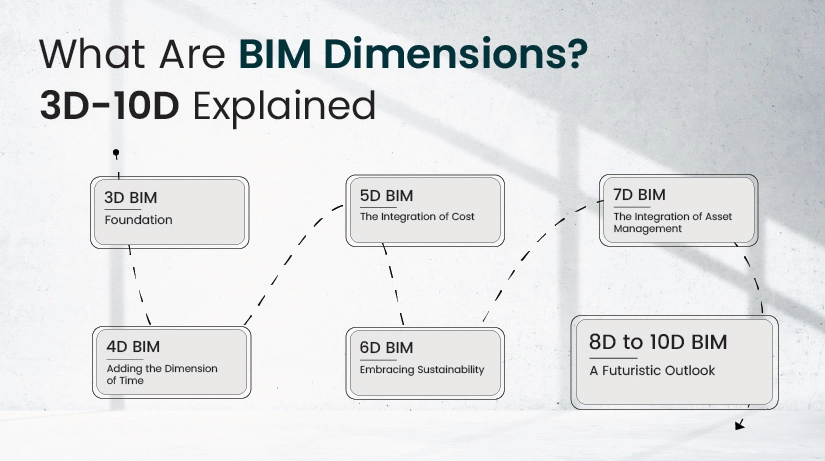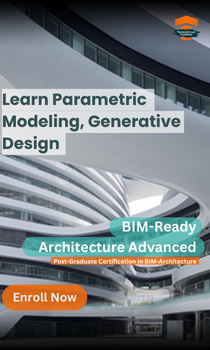What Are BIM Dimensions? 3D-10D Explained
Jan 08, 2024
Category: BIM / Digitization / Automation
SEO TSA

In recent years, the construction and architecture industry has experienced a profound transformation through BIM. This groundbreaking methodology has revolutionized the traditional approaches to designing and constructing structures and given rise to BIM dimensions. BIM transcends conventional methodologies, providing a holistic approach that extends beyond design and construction.
From the foundational 3D BIM, which brings spatial representations to life, to the futuristic possibilities of 8D-10D, BIM dimensions empower stakeholders to make informed decisions at every stage of a project’s life cycle, aiming to demystify the intricacies of BIM dimensions and collective impact on the evolving landscape of construction and architecture.
Understanding BIM
In the dynamic realm of construction and architectural design, Building Information Modeling (BIM) dimensions signify a transformative departure from conventional 2D drafting methods, ushering in a more comprehensive and intelligent approach to project planning. At its core, BIM dimensions encapsulate layers of information embedded within a digital model.
BIM initiates the foundational 3D BIM, transforming architectural concepts into digital models. It forms the basis for subsequent dimensions, each introducing elements such as time, cost, sustainability, and asset management. The progression from 3D to 4D includes the temporal dimension, allowing the visualization of construction sequences and optimization of project schedules.
The 5D integrates cost considerations, fostering informed decision-making. Expanding further, 6D integrates sustainability data, and 7D delves into detailed asset management. Together, these dimensions transform the digital model into a tool for collaboration, decision-making, and long-term facility management, marking a shift in the way the construction industry approaches projects.
| Also Read: 6 Reasons to Implement BIM in the AEC Industry
Foundation of 3D BIM
BIM dimensions represent the different aspects and layers of information incorporated into a BIM model. It starts with the foundational 3D BIM, where the spatial representation of a building comes to life. This three-dimensional model forms the core of BIM, providing architects and engineers with a visual representation of the structure.
In 3D BIM, the focus is on the physical components, allowing stakeholders to navigate and explore the design in a virtual environment.
Significance of 3D BIM
♦ 3D BIM lays the groundwork for effective collaboration among architects, engineers, and other stakeholders. It enhances communication by providing a shared visual understanding of the project.
♦ This dimension enables professionals to identify potential clashes and conflicts in the design early in the process, leading to more efficient problem-solving and a reduction in costly revisions during the construction phase.
4D BIM: Adding the Dimension of Time
As the construction industry embraced the power of BIM, the need for incorporating time-based information became evident. This led to the emergence of 4D BIM, where the element of time is integrated into the 3D model. In 4D BIM, the construction sequence is simulated, allowing stakeholders to visualize the project’s progression over time.
This dimension is a game-changer, enabling project managers to optimize schedules, allocate resources efficiently, and identify potential delays before they impact the timeline.
Benefits of 4D BIM
♦ 4D BIM facilitates better project planning and management. By visualizing the construction sequence, project teams can identify bottlenecks, streamline workflows, and ensure that resources are allocated judiciously.
♦ This results in improved project efficiency, reduced delays, and enhanced overall project control. Additionally, stakeholders gain a deeper understanding of the project’s timeline, fostering better communication and collaboration throughout the construction lifecycle.
5D BIM: The Integration of Cost
Building upon the foundation of 3D and 4D, 5D BIM introduces the crucial element of cost into the equation. This dimension integrates cost data with the 3D model and construction timeline, providing a comprehensive view of the project’s financial aspects.
By associating costs with specific components and activities, stakeholders can make informed decisions, manage budgets effectively, and avoid cost overruns.
Empowering Decision-Making with 5D BIM
♦ One of the key advantages of 5D BIM is its ability to empower decision-makers with real-time cost information.
♦ Project managers can assess the financial implications of design changes, material choices, and construction methods, allowing them to make informed decisions that align with budgetary constraints.
♦ This proactive approach to cost management enhances financial transparency and accountability, contributing to the overall success of the project.
6D BIM: Embracing Sustainability
In the pursuit of a more intelligent and sustainable built environment, the industry introduced 6D BIM. This dimension goes beyond the physical aspects of a building, incorporating data related to sustainability and facility management.
By integrating information about energy consumption, life cycle analysis, and maintenance requirements, 6D BIM equips stakeholders with the tools needed to make environmentally conscious decisions throughout the building’s life cycle.
Maximizing Building Performance with 6D BIM
♦ 6D BIM empowers facility managers with insights into the long-term performance of a building.
♦ By considering factors such as energy efficiency and maintenance requirements during the design and construction phases, stakeholders can optimize building performance and reduce environmental impact.
♦ This dimension aligns with the industry’s growing emphasis on sustainable and responsible construction practices.
7D BIM: The Integration of Asset Management
As the BIM journey evolves, the industry recognizes the importance of comprehensive asset management. 7D BIM takes the digital twin concept to the next level by incorporating detailed information about each building component’s life cycle. This includes data on warranties, specifications, and recommended maintenance schedules, providing a holistic view of the building’s entire lifespan.
Enhancing Facility Management with 7D BIM
♦ 7D BIM is a valuable tool for facility managers responsible for maintaining and optimizing building performance.
♦ By leveraging detailed asset information, maintenance teams can schedule preventive maintenance more effectively, reducing downtime and extending the lifespan of building components.
♦ This dimension ensures that facilities operate at peak efficiency throughout their life cycle, maximizing the return on investment for building owners.
8D to 10D BIM:
While the current industry standard encompasses dimensions up to 7D, there is ongoing exploration and discussion about the possibilities of 8D-10D BIM. These dimensions would likely involve advanced artificial intelligence, machine learning, and predictive analytics to further enhance the capabilities of BIM models.
BIM integration is rapidly evolving in the AEC industry. The integration of real-time data, smart technologies, and advanced analytics could pave the way for unprecedented levels of efficiency, sustainability, and resilience in the construction and operation of built environments.
Anticipated Benefits of 8D-10D BIM
♦ The evolution of BIM into higher dimensions holds the promise of even greater automation, precision, and optimization.
♦ Anticipated benefits include enhanced risk management, more accurate predictive modeling, and improved resilience against unforeseen challenges.
♦ As technology continues to advance, the industry is poised to unlock new frontiers in construction and design, ushering in an era of unparalleled sophistication and efficiency.
Conclusion
In this ever-evolving realm, the synergy of design, construction, and operation paves the way for a future where buildings are dynamic, adaptable entities. The understanding provided by these dimensions empowers stakeholders to make informed decisions, minimize risks, and contribute to creating spaces that endure the test of time and positively impact the communities they serve.
In the construction industry, exploring BIM dimensions illuminates the path toward a more intelligent and sustainable future. AI, machine learning, and real-time data in higher dimensions signify a continued commitment to innovation. The construction industry meets the challenges of the future and sets new standards for resilience, sustainability, and operational excellence.
TechnoStruct Academy is the perfect educational institution for BIM training courses and certification programs. With a focus on BIM engineering tailored for designing and architecture, MEP, and BIM Management, TSA delivers specialized training. The academy goes beyond traditional approaches, offering project-centric and software-agnostic instruction suitable for both undergraduate and postgraduate students.
FAQs
Q1. What does the D dimension BIM mean?
Ans. BIM dimensions, including 3D, 4D, 5D, 6D, and 7D, pertain to the nature and presentation of information within a BIM model. They serve to enrich the data within the model, promoting a heightened level of comprehension and transparency in construction projects.
Q2. What are BIM levels?
Ans. BIM levels serve distinct purposes across various project types, signifying different levels of ‘maturity’ ranging from level 0 to 6. The objective of employing BIM levels is to integrate accurate and pertinent information into the BIM model throughout the entirety of the design-build process.
Q3. What is the difference between BIM and 3D?
Ans. The primary distinction between BIM and 3D CAD lies in the depth of information, as a BIM file surpasses a 3D CAD file in richness by incorporating extensive details such as performance characteristics, specifications, and other non-physical data within a collaborative 3D digital representation of the project.








